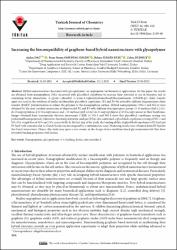| dc.contributor.author | Dağ, Aydan | |
| dc.contributor.author | Omurtag Özgen, Pınar Sinem | |
| dc.contributor.author | Zengin Kurt, Belma | |
| dc.contributor.author | Durmuş, Zehra | |
| dc.date.accessioned | 2022-05-20T13:11:06Z | |
| dc.date.available | 2022-05-20T13:11:06Z | |
| dc.date.issued | 2022 | en_US |
| dc.identifier.citation | Dağ, A., Omurtag Özgen, P. S., Zengin Kurt, B. ve Durmuş, Z. (2022). Increasing the biocompatibility of graphene-based hybrid nanostructures with glycopolymer. Turkish Journal of Chemistry, 46(2), 404-414. https://doi.org/10.3906/kim-2109-60 | en_US |
| dc.identifier.issn | 1300-0527 | |
| dc.identifier.uri | https://doi.org/10.3906/kim-2109-60 | |
| dc.identifier.uri | https://hdl.handle.net/20.500.12511/9461 | |
| dc.description.abstract | Hybrid nanostructures decorated with glycopolymers are appropriate for biomedical applications. In this paper, the results are obtained from nanographene (NG) decorated with glycoblock copolymer to increase their potential in use in therapies and in examining lectin interactions. A pyren-1-ylmethyl 4-cyano-4-((phenylcarbonothioyl)thio)pentanoate (CPADB-py) chain transfer agent was used in the synthesis of methyl methacrylate glycoblock copolymers (P2 and P3) by reversible addition-fragmentation chain transfer (RAFT) polymerization to adhere the polymer to the nanographene surface. Hybrid nanographenes (NG-1 and NG-2) were obtained by the non-covalent interaction of deprotected P2 and P3 with different fructopyranose groups (3-O-methacryloyl-1,2:4,5- di-O-isopropylidene-β-D-fructopyranose and 1-O-methacryloyl-2,3:4,5-di-O-isopropylidene-β-D-fructopyranose) in their backbones. Images obtained from transmission electron microscopy (TEM) of NG-1 and NG-2 show that glycoblock copolymer coating was performed homogeneously. Moreover, thermal gravimetric analysis (TGA) also confirmed a glycoblock copolymer coating of NG-1 and NG-2 by weight loss of 41% and 31%, respectively. In the last step of the study, the binding ability of glycoblock copolymers (P2-hyd and P3-hyd) with concanavalin A (ConA) lectin was investigated by a turbidimetric assay. Promising results were obtained from P3-hyd for the ConA interactions. Hence, this study may open a new avenue in the design of new multifunctional glyconanomaterials that show favorable binding properties with lectins. | en_US |
| dc.description.sponsorship | Bezmialem Vakif University | en_US |
| dc.language.iso | eng | en_US |
| dc.publisher | Scientific Technical Research Council Turkey-TUBITAK | en_US |
| dc.rights | info:eu-repo/semantics/openAccess | en_US |
| dc.rights | Attribution 4.0 International | * |
| dc.rights.uri | https://creativecommons.org/licenses/by/4.0/ | * |
| dc.subject | Concanavalin A | en_US |
| dc.subject | Glycopolymer | en_US |
| dc.subject | Lectin | en_US |
| dc.subject | Nanographene | en_US |
| dc.subject | π-π Stacking | en_US |
| dc.title | Increasing the biocompatibility of graphene-based hybrid nanostructures with glycopolymer | en_US |
| dc.type | article | en_US |
| dc.relation.ispartof | Turkish Journal of Chemistry | en_US |
| dc.department | İstanbul Medipol Üniversitesi, Eczacılık Fakültesi, Temel Eczacılık Bilimleri Bölümü, Analitik Kimya Ana Bilim Dalı | en_US |
| dc.authorid | 0000-0003-2493-9664 | en_US |
| dc.identifier.volume | 46 | en_US |
| dc.identifier.issue | 2 | en_US |
| dc.identifier.startpage | 404 | en_US |
| dc.identifier.endpage | 414 | en_US |
| dc.relation.publicationcategory | Makale - Uluslararası Hakemli Dergi - Kurum Öğretim Elemanı | en_US |
| dc.identifier.doi | 10.3906/kim-2109-60 | en_US |
| dc.institutionauthor | Omurtag Özgen, Pınar Sinem | |
| dc.identifier.wosquality | Q4 | en_US |
| dc.identifier.wos | 000787795800001 | en_US |
| dc.identifier.scopus | 2-s2.0-85129300530 | en_US |
| dc.identifier.scopusquality | Q3 | en_US |



















